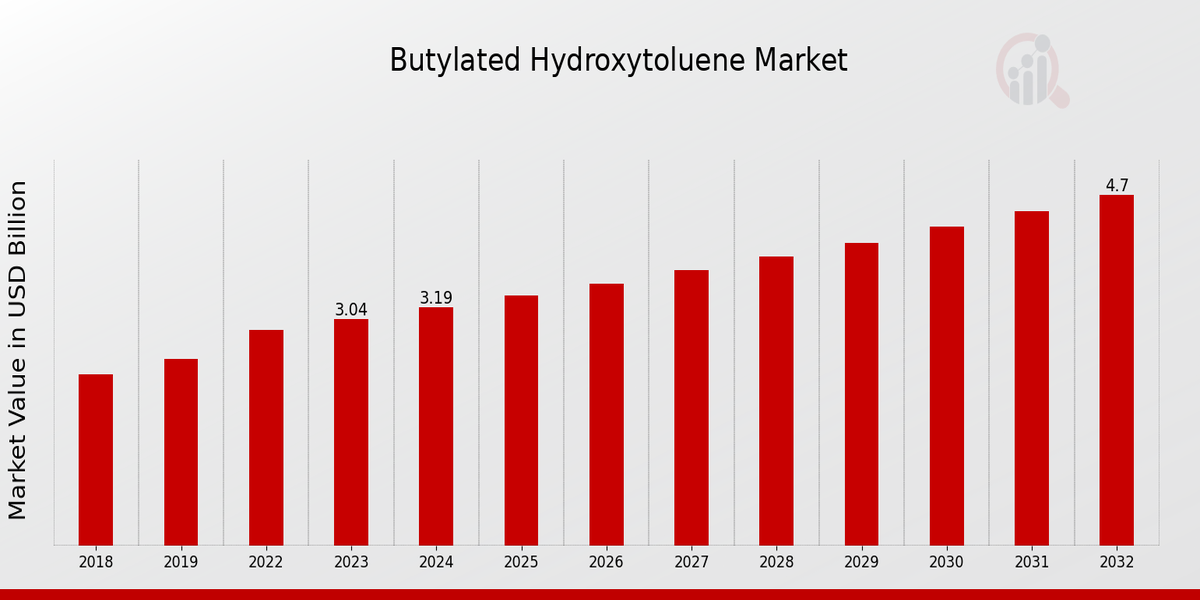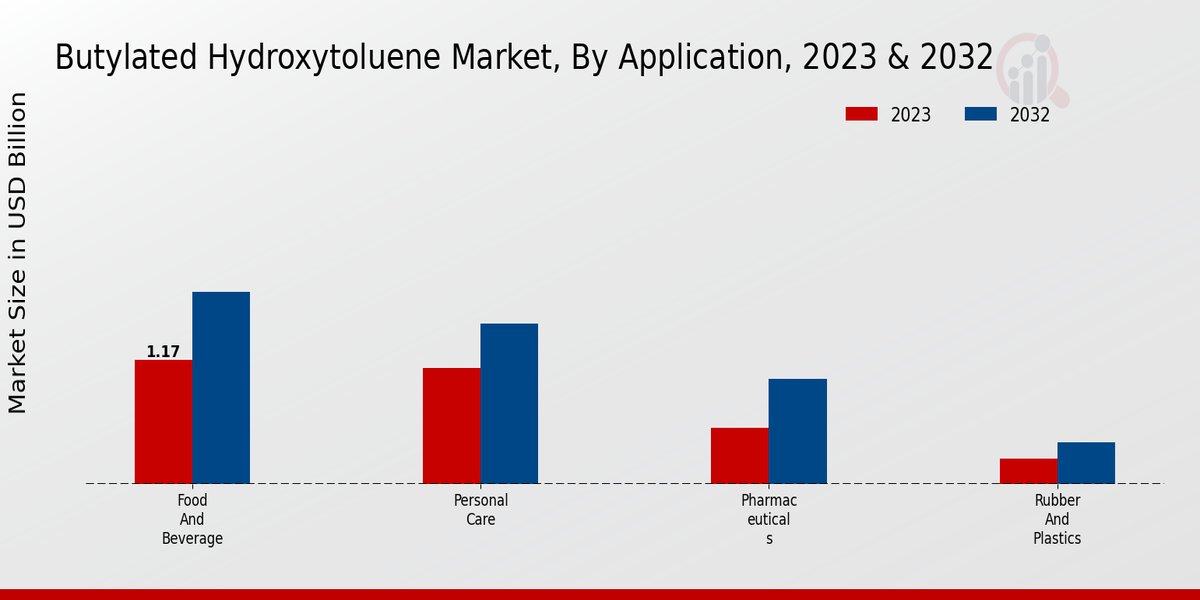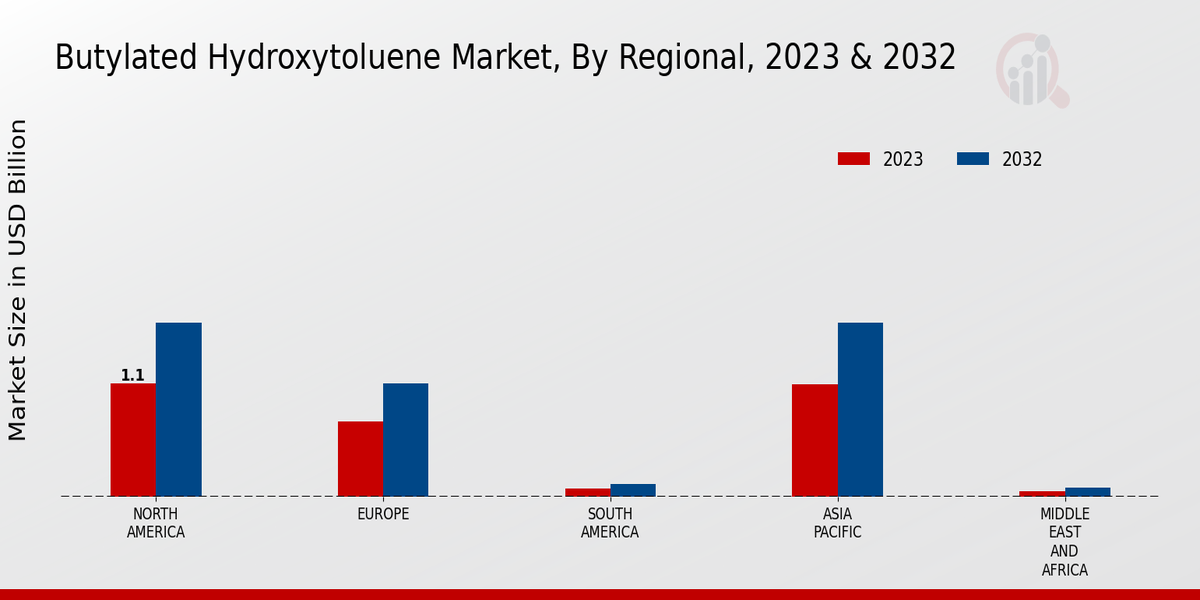Butylated Hydroxytoluene Market Overview
The Butylated Hydroxytoluene Market Size was estimated at 3.34(USD Billion) in 2024. The Butylated Hydroxytoluene Industry is expected to grow from 3.51(USD Billion) in 2025 to 5.44(USD Billion) by 2034. The Butylated Hydroxytoluene Market CAGR (growth rate) is expected to be around 5.00% during the forecast period (2025 - 2034).
Key Butylated Hydroxytoluene Market Trends Highlighted
Because butylated hydroxytoluene is widely used as an antioxidant across a variety of industries, the market for this product is expanding significantly on a global scale.
The market's growth has been driven by the rising demand for pharmaceuticals, personal care items, and food additives.
Opportunities for the use of butylated hydroxytoluene in health supplements have arisen because of increased knowledge about oxidative stress and its connection to chronic illnesses.
Furthermore, the market for butylated hydroxytoluene as a secure and efficient antioxidant is being driven by the trend toward natural and organic chemicals.

Source: Primary Research, Secondary Research, MRFR Database and Analyst Review
Butylated Hydroxytoluene Market Drivers
Growing Demand for Packaged Food and Beverages
Butylated hydroxytoluene (BHT) is a synthetic antioxidant widely used in the food and beverage industry to prevent oxidation and extend the shelf life of products. The increasing demand for packaged food and beverages, particularly in emerging markets, is a key driver of the global BHT market.
As consumers become more health-conscious, they are demanding food and beverages that are free from synthetic additives. However, BHT remains an essential ingredient in many food and beverage products due to its effectiveness and low cost.
The growing demand for packaged food and beverages is expected to continue to drive the growth of the global BHT market in the coming years. The global packaged food and beverage market is expected to reach a value of USD 4.2 trillion by 2027, growing at a CAGR of 3.5% from 2022 to 2027.
The growth of the packaged food and beverage market is attributed to factors such as increasing urbanization, rising disposable incomes, and changing lifestyles.
Packaged food and beverages offer convenience, longer shelf life, and protection from contamination, which makes them attractive to consumers.
The growing demand for packaged food and beverages is expected to drive the demand for BHT, as it is an essential ingredient in many food and beverage products.
Butylated hydroxytoluene (BHT) is a synthetic antioxidant that is used to prevent the oxidation of fats and oils in food and beverage products. BHT is a white, crystalline powder that is soluble in oil and insoluble in water.
It is used in a wide variety of food and beverage products, including cereals, crackers, chips, nuts, meat products, and vegetable oils. BHT is also used in some cosmetics and personal care products. The global BHT market is expected to grow at a CAGR of 4.98% from 2024 to 2032.
The growth of the market is attributed to the increasing demand for packaged food and beverages, the rising awareness of the benefits of antioxidants, and the growing demand for BHT in non-food applications.
The Asia-Pacific region is expected to be the largest market for BHT, followed by North America and Europe.
Rising Health Consciousness Among Consumers
Consumers are becoming increasingly health-conscious and are demanding food and beverage products that are free from harmful chemicals and additives. BHT is a synthetic antioxidant that has been linked to several health concerns, including cancer and developmental toxicity.
As a result, consumers are increasingly seeking out food and beverage products that are free from BHT. This trend is expected to continue to drive the growth of the global BHT market in the coming years.
The rising health consciousness among consumers is also leading to a growing demand for natural and organic food and beverage products.
Natural and organic food and beverage products are perceived as being healthier and more environmentally friendly than conventional products.
BHT is not a natural ingredient, and it is not allowed in organic food and beverage products. This is another factor that is expected to contribute to the growth of the global BHT market in the coming years.
Growing Demand for BHT in Non-Food Applications
Moreover, BHT is not limited to the production of different foods and beverages. It is often utilized in various non-food applications.
On the one hand, “BHT is used in the plastics and rubber industry as an antioxidant in order to prevent the polymer from degradation”.
On the other hand, BHT can be used in cosmetics to prevent the growth of bacteria or fungi. In such a way, the growing demand for different types of plastics as well as rubber and cosmetics is one of the important factors that influence the non-food applications.
Butylated Hydroxytoluene Market Segment Insights:
Butylated Hydroxytoluene Market Application Insights
The Butylated Hydroxytoluene Market is segmented by application into Food and Beverage, Personal Care, Pharmaceuticals, Rubber and Plastics, and Others.
The Food and Beverage segment was the largest application area in 2023, reaching more than 40% of the global market. The main driver for the Food and Beverage industry is that Butylated Hydroxytoluene serves as an antioxidant to prevent the oxidation of fats and oils.
In turn, oxidation causes fats to become rancid, leading to a spoiled food experience. The second largest application area is Personal Care, where Butylated Hydroxytoluene consumed nearly 25% of the market in 2023.
Antioxidants like Butylated Hydroxytoluene help personal care products like cosmetics, skincare, and hair care to preserve the effectiveness of active ingredients. The third largest application area is Pharmaceuticals, which consumed nearly 15% of the global market revenue in 2023.
In the case of pharmaceutical formulations, antioxidants like Butylated Hydroxytoluene protect the active ingredients from degradation and increase the lifespan of drugs in storage.
Rubber and Plastics represent the fourth largest application area, where consumers used about 10% of the market in 2023.
High-performance materials like rubber and plastic require antioxidants to preserve their carefully planned formulation and properties, increasing the product lifespan.
Finally, the others category is the smallest application segment with less than 10% of the market in 2023 and includes applications of Butylated Hydroxytoluene in metalworking fluids, lubricants, and coatings. Butylated Hydroxylanassaultene is applied to prevent oxidation and increase product lifespan.
Overall, the Butylated Hydroxytoluene Market is expected to continue growing due to the growing demand for antioxidants in all the abovementioned application areas.

Source: Primary Research, Secondary Research, MRFR Database and Analyst Review
Butylated Hydroxytoluene Market Form Insights
The Butylated Hydroxytoluene Market segmentation based on the form includes Liquid and Powder. Liquid Butylated Hydroxytoluene is projected to dominate the market in 2024, accounting for a revenue share of approximately 58.0%.
The growing demand for liquid Butylated Hydroxytoluene in various industries, including food, pharmaceuticals, and cosmetics, is attributed to its ease of handling, precise dosage, and better solubility.
It also exhibits superior antioxidant properties, making it a preferred choice for stabilizing emulsions and preventing oxidation.
Powder Butylated Hydroxytoluene, on the other hand, is expected to witness a steady growth rate during the forecast period.
It finds applications in dry food products, such as cereals, spices, and powdered beverages, where moisture content needs to be controlled.
Butylated Hydroxytoluene Market Grade Insights
The Butylated Hydroxytoluene Market is segmented by Grade into Technical Grade, Food Grade, and Pharmaceutical Grade.
The Technical Grade segment held the largest market share in 2023, accounting for approximately 40% of the Butylated Hydroxytoluene Market revenue.
The Food Grade segment is expected to grow at the highest CAGR during the forecast period, owing to the increasing demand for food additives that prevent spoilage.
The Pharmaceutical Grade segment is expected to hold a significant market share, driven by the growing demand for antioxidants in the pharmaceutical industry.
Butylated Hydroxytoluene Market Distribution Channel Insights
The Butylated Hydroxytoluene Market segmentation by Distribution Channel includes Direct Sales, Distributors, Retailers, and Online Platforms.
In 2023, the Butylated Hydroxytoluene Market revenue from Direct Sales was valued at USD 1.24 billion, and it is projected to reach USD 1.98 billion by 2032, exhibiting a CAGR of 5.2% during the forecast period.
Distributors held a significant market share in 2023, accounting for around 35% of the Butylated Hydroxytoluene Market revenue.
The growth of the Direct Sales channel is attributed to the increasing preference of manufacturers to sell directly to customers, enabling better control over pricing and distribution.
Additionally, the rise of e-commerce platforms has fueled the growth of the Online Platforms segment, which is expected to witness a notable CAGR of 6.3% over the forecast period.
Butylated Hydroxytoluene Market Regional Insights
North America is expected to hold the largest share of the Butylated Hydroxytoluene Market in 2023, owing to the high demand for processed food products and stringent regulations concerning food safety.
Growing awareness about health hazards related to the consumption of oxidized food products is fueling the demand for antioxidants like BHT.
Europe stands as the second-largest regional market, with regulations promoting the use of BHT in various applications.
APAC is anticipated to witness significant growth over the forecast period, driven by rising disposable incomes and the expanding food industry in developing countries.
South America and MEA are expected to contribute moderately to the overall market growth, with increasing demand from the pharmaceutical and plastics industries.

Source: Primary Research, Secondary Research, MRFR Database and Analyst Review
Butylated Hydroxytoluene Market Key Players and Competitive Insights:
Constantly striving major players in the Butylated Hydroxytoluene Market to gain a competitive edge through investments in research and development, expand product offerings, and adopt innovative marketing strategies.
Leading players in the Butylated Hydroxytoluene Market are interested in developing and launching new products that closely match the customer’s needs. Companies are extending market reach into new markets and are partnering with local distributors and suppliers.
Butylated Hydroxytoluene Market growth is being driven by rising demand for antioxidants in food, pharmaceutical, and cosmetic industries.
Moreover, with the increasing awareness of the harmful effects of free radicals and the need for antioxidants to protect cells from damage, the Butylated Hydroxytoluene Market products are witnessing a rising demand.
Butylated Hydroxytoluene Market Competitive Landscape is poised to be hotly contested over the next few years, with key firms competing for market share through product innovation, strategic acquisitions, and relentless marketing campaigns.
A company in the Butylated Hydroxytoluene Market is Shandong Hongye Chemical Co., Ltd. The company is based in China and has an extensive history of delivering high-quality products that rely on the most innovative technologies.
Shandong Hongye Chemical Co., Ltd. boasts a range of products in its vast portfolio, including various antioxidants and Butylated Hydroxytoluene. The company has a strong focus on innovations through heavy investments in research and development.
Shandong Hongye Chemical Co., Ltd. exports products to more than 50 countries and has an extensive and well-developed distribution network that helps the company promptly and efficiently meet the needs of its customers.
A company in Butylated Hydroxytoluene Market is Bayer AG. BASF SE is a German company and is one of the largest multinational chemical companies in the world.
BASF SE is well-known as a Butylated Hydroxytoluene Market player. BASF SE operates in many countries around the world and employs approximately 113,000 people.
The company is well known for its commitment to sustainability and its desire to reduce its environmental footprint.
Its Butylated Hydroxytoluene products are available in nearly all countries, and demand specialists are well-equipped to meet customer needs promptly and efficiently.
Key Companies in the Butylated Hydroxytoluene Market Include:
-
Eastman Chemical Company
-
Chevron Phillips Chemical Company LLC
-
LyondellBasell Industries Holdings BV
-
Merck Group
-
Lanxess AG
-
Sigma-Aldrich
-
BASF SE
-
Solvay SA
-
Dow Chemical Company
-
Arkema SA
-
Ineos Group AG
-
ExxonMobil Chemical Company
-
PetroChina Company Limited
-
SABIC
-
Evonik Industries AG
Butylated Hydroxytoluene Market Developments
The increasing demand for BHT as an antioxidant in food, plastics, and rubber industries is driving market growth.
The rising awareness about the adverse effects of synthetic antioxidants is also contributing to the market's expansion.
Key industry participants are focusing on product innovation and capacity expansion to meet the growing demand.
Recent developments include the launch of new grades of BHT with improved performance characteristics and the establishment of new production facilities in emerging markets.
Butylated Hydroxytoluene Market Segmentation Insights
-
Butylated Hydroxytoluene Market Application Outlook
-
Food and Beverage
-
Personal Care
-
Pharmaceuticals
-
Rubber and Plastics
-
Others
-
Butylated Hydroxytoluene Market Form Outlook
-
Butylated Hydroxytoluene Market Grade Outlook
-
Technical Grade
-
Food Grade
-
Pharmaceutical Grade
-
Butylated Hydroxytoluene Market Distribution Channel Outlook
-
Direct Sales
-
Distributors
-
Retailers
-
Online Platforms
-
Butylated Hydroxytoluene Market Regional Outlook
-
North America
-
Europe
-
South America
-
Asia Pacific
-
Middle East and Africa
| Report Attribute/Metric |
Details |
| Market Size 2024 |
3.34(USD Billion) |
| Market Size 2025 |
3.51(USD Billion) |
| Market Size 20324 |
5.44(USD Billion) |
| Compound Annual Growth Rate (CAGR) |
5.00% (2025 - 2034) |
| Report Coverage |
Revenue Forecast, Competitive Landscape, Growth Factors, and Trends |
| Base Year |
2024 |
| Market Forecast Period |
2025 - 2034 |
| Historical Data |
2020 - 2024 |
| Market Forecast Units |
USD Billion |
| Key Companies Profiled |
Eastman Chemical Company, Chevron Phillips Chemical Company LLC, LyondellBasell Industries Holdings BV, Merck Group, Lanxess AG, Sigma-Aldrich, BASF SE, Solvay SA, Dow Chemical Company, Arkema SA, Ineos Group AG, ExxonMobil Chemical Company, PetroChina Company Limited, SABIC, Evonik Industries AG |
| Segments Covered |
Application, Form, Grade, Distribution Channel, Regional |
| Key Market Opportunities |
Antioxidant demand in food and personal care Plastic industry growth Pharmaceutical applications |
| Key Market Dynamics |
Rising food and beverage demand, increasing use in personal care and pharmaceuticals, and the growing awareness of antioxidants. |
| Countries Covered |
North America, Europe, APAC, South America, MEA |
Frequently Asked Questions (FAQ) :
The Butylated Hydroxytoluene Market is expected to exhibit a CAGR of 5.00% during the forecast period of 2025-2034.
The Butylated Hydroxytoluene Market is anticipated to be valued at approximately USD 3.51 billion in 2025.
The Butylated Hydroxytoluene Market is projected to reach a valuation of around USD 5.44 billion by 2034.
The Asia-Pacific region is anticipated to account for a significant share of the Butylated Hydroxytoluene Market due to the growing demand from emerging economies like China and India.
Butylated Hydroxytoluene finds extensive applications in various industries, including food packaging, pharmaceuticals, rubber, and plastics, to enhance product shelf life and stability.
Some of the prominent companies operating in the Butylated Hydroxytoluene Market include BASF SE, Merck KGaA, and Lanxess AG.
The increasing demand for packaged food products, the growing pharmaceutical industry, and the rising awareness about food safety are driving the growth of the Butylated Hydroxytoluene Market.
The stringent regulations regarding the use of synthetic antioxidants and the potential health concerns associated with Butylated Hydroxytoluene could pose challenges to market growth.
The development of natural and plant-based antioxidants as alternatives to Butylated Hydroxytoluene is gaining traction in the market.
The COVID-19 pandemic had a moderate impact on the Butylated Hydroxytoluene Market. The initial disruptions in supply chains and production were gradually overcome, and the market is expected to recover in the coming years.

















